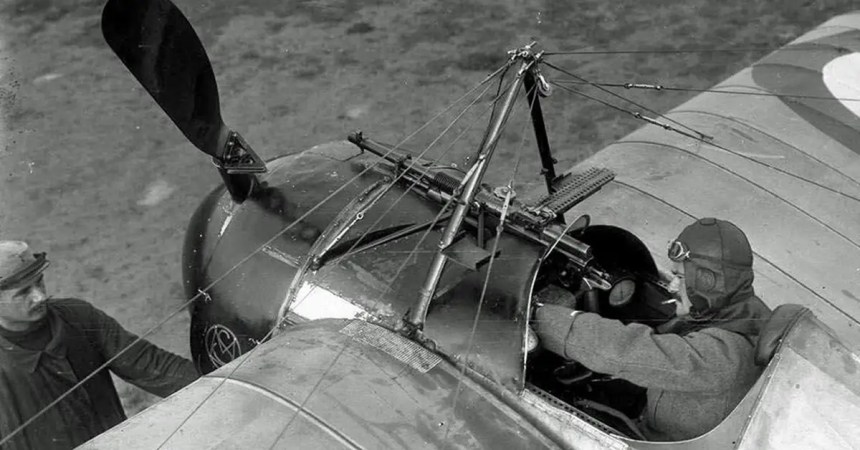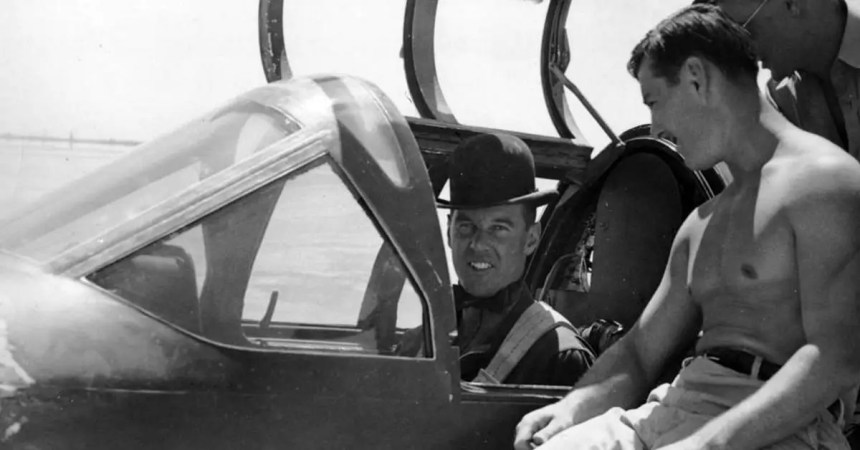World War I pilots began by simply waving at each other in flight, greeting their adversary as each pilot headed to his own reconnaissance mission. But as World War I quickly became brutal—and the pilots themselves saw friends die on the ground by the thousands and in the air by the dozens—they quickly sought out ways to kill each other.
And one of the pioneers who pulled it off was Roland Garros, a daredevil pilot who barely escaped Germany with a night flight into Switzerland at the war’s start.

French Pilot Roland Garros in a plane with a canine.
(Public domain)
Garros was a French pilot who had already made a name for himself as a daredevil and aviation expert by flying across the Mediterranean in 1913. But when World War I broke out, he was in Germany and made his unscheduled night flight into Switzerland to get away, quickly joining the Storks Squadron, a group of aviators who would be the highest ranked French air-to-air combatants in the war.
And Garros led the way. Fighter combat in the air began with pilots carrying pistols to shoot at enemy aviators and darts to drop on hostile troops on the ground. But most pilots were looking for some way to mount machine guns on their planes.
But pilots usually looked through propeller blades while flying, and that was the most logical place to mount a gun for pilots to control. But, obviously, shooting through their own propeller would inevitably cause the pilot to shoot down himself. One of the early fixes was to mount the machine gun above the propeller blades, but that pointed the gun into a weird angle, and no one was able to shoot anyone down with that configuration.
Garros figured out another way. He mounted his gun right in front of his seat so he could look down the barrel to aim. To get around the problem of destroying his propeller, he simply armored the wooden blades with a metal sheath and trusted them to deflect those rounds that would’ve downed him while the rest of the rounds flew toward his target.
It is sometimes counted as the first known aerial victory, though it’s important to note that “aerial victory” today is often used to refer to shooting down an enemy plane, not forcing it to run. That feat was first accomplished Oct. 5 by another French pilot.

An illustration of aerial combat in World War I.
(Public domain)
But Garros would go on to down five enemy planes in March 1915, causing the American press to dub him an “ace,” one of the first times that term was used. He also may have been the first pilot to achieve five kills.
Either way, his bravery, and ingenuity helped put France at the forefront of the changing face of aerial warfare. Unfortunately, air combat was a risky business, and Garros would not survive the war. In April 1915, he was shot down and crashed behind German lines.
He quickly attempted to burn his plane to hide how the forward-firing machine gun worked, but he was captured before he could complete the coup. He would spend the next three years in a prisoner of war camp before escaping, achieving new aerial victories in 1918, but then dying in combat on Oct. 5,1918.


























